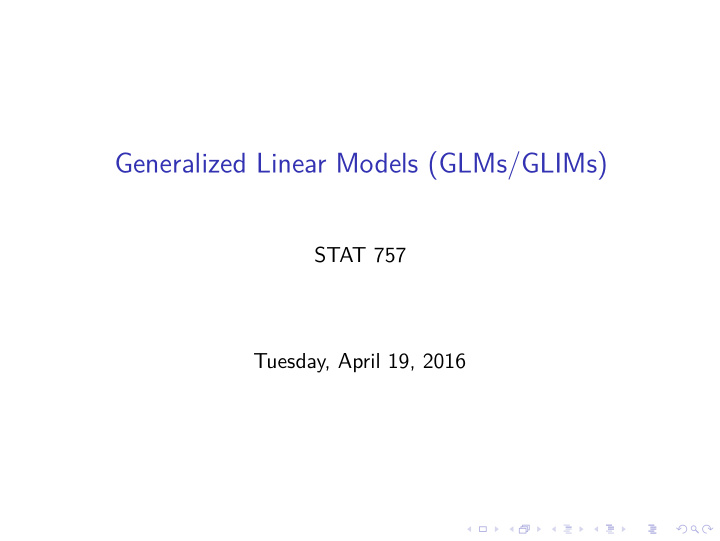



Generalized Linear Models (GLMs/GLIMs) STAT 757 Tuesday, April 19, 2016
Model Framework The GLM is described by three components: 1. The random component specifies the conditional distribution of y i | � x i and is typically a member of the exponential family of distributions (Normal, binomial, Poisson, Negative-binomial, etc.) but other distributions are possible. 2. We call our linear sum of predictors the linear predictor , and denote it as η i = β 0 + � p j =1 β j x ij 3. We call the transformation that links the expected response values µ i = E ( y i | � x ) and the linear predictor η i the link function : g ( µ i ) = η i . This link function is assumed to be smooth (differentiable) and invertible. It’s inverse g − 1 is often called the mean function since µ i = g − 1 ( η i ).
GLM vs MLR Recall the MLR model with untransformed response values can be written as p � y i = β 0 + β j x ij + ǫ i . j =1 In that case, we model E ( g ( y i )) as a linear sum of x i values, and further assume Normal errors with constant variance. Consider, for now, the simple untransformed case (i.e., g is the identity function).
GLM vs MLR One could pose the MLR model as a GLM (not to be confused with a General Linear Model) as follows: 1. The random component is Normally distributed. 2. The linear predictor is η i = β 0 + � p j =1 β j x ij (nothing new here!) 3. The link function is the identity function: g ( E ( y i )) = E ( y i ) = η i
GLM vs MLR Note that transforming Y values under MLR is different than specifying a non-identity link function! GLMs model g ( E ( y i )), the transformed expecation of the response, using the linear predictor. This gives more flexibility to apply linearizing transformations without affecting the distribution about that trend. For example, compare the two models by comparing y i values and inverse-transforms: MLR: y i = g − 1 ( η i + ǫ i ) GLM: y i = g − 1 ( η i ) + ǫ i This distinction often makes GLMs preferrable over MLR.
Parameter Estimation, etc. Parameter estimation is done via Maximum Liklihood, and most of the diagnostics for multiple linear regresion carry over to GLMs. For more information, please see Ch. 15 of Applied Regression Analysis & Generalized Linear Models by John Fox. http://www.sagepub.com/sites/default/files/ upm-binaries/21121_Chapter_15.pdf
Example: Logistic Regression (Sheather, Ch. 8) A common form of response data are counts of a particular type of outcome among m trials. For example, the number of individuals in a sample with a specific genotype. In such cases, the data are best modeled using a binomial distribution, not a Normal distribution, using logistic regression . E ( Y | x ) ∼ binom ( m , θ )
Example: Logistic Regression (Sheather, Ch. 8) Here the parameter of interest is p (or θ ) – the probability of a success on each of our n (or m ) trials. Since m is known and not a parameter that needs to be estimated, the goal is to estimate θ as a function of our linear predictor. In logistic regression, this is done by assuming exp( η i ) m E ( Y | X ) = m θ = m 1 + exp( η i ) = 1 + exp( − η i ) Thus, a little algebra gives that θ ( x ) � � η i = log 1 − θ ( x ) We call the right side of that equation the logit function, and θ/ (1 − θ ) the odds .
Example: Logistic Regression (Sheather, Ch. 8) To see how this can be cast as a GLM, note that: 1. The distribution is binomial. 2. The relationship between the mean (let’s use E( y i / m = θ i )) and linear predictor η i is given by the logit function θ ( x ) � � η i = g ( θ ) = log 1 − θ ( x ) Exercise: Work through the examples from Sheather, Ch. 8. (Are there alternative link functions?)
Recommend
More recommend